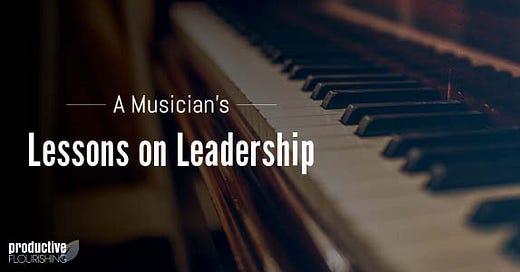A Musician's Lessons on Leadership

Editor’s note: This is a guest post from Breanne Dyck.
Have you ever heard a piano that sounds tinny? Or one that sounds a little thin, cheap, or a bit like it came out of some old-timey saloon? It’s not that it sounds desperately out of tune per se…but it’s clearly not the robust, warm, rich tones we like to hear from a piano.
But, of course, the piano is out of tune. Or, more correctly, it’s out of unison.
But I’m getting ahead of myself. Let me back up for a moment.
You see, I’ve been involved in music from a very early age. Years of piano lessons, a few months of violin, an interlude of middle school trumpet, random occasions filling in as a percussionist in band class, handbells, jazz band, jazz choir, vocal solo, composing, arranging…
It’s safe to say I’ve practiced, played, and performed music my whole life.
What I didn’t realize until recently, though, is that I didn’t just spend all those years honing my musicianship. I was also learning vital lessons on leadership and leading high-performing teams.
“I’ve Got Rhythm, I’ve Got Music…”
The connection started to become apparent when I found myself explaining rhythm to a client.
The client was, like many of the business owners my company works with, trying to get out of the day-to-day of her business: She would hire, she would delegate, she would do all the “right things.” Yet, she still found herself sucked into the weeds, wondering when she’d ever get to do the work she found most personally meaningful.
And as we dug into what was going on, we discovered the core reason for her struggle: She hadn’t established a new rhythm for herself.
Rhythm, you see, is the interplay between the rests and the notes; the fast and the slow; duration and the beat. It’s what makes the notes into music, not just noise.
So long as you obey the beat that the measure lays out, you have enormous flexibility. You can fit three notes into the space that usually takes two, or two into the space that usually takes three. You can speed up, or slow down.
You can do any number of things — but what you cannot do is play the notes for one song with the rhythm of another, and hope it all works out in the end.
“Rhythm,” I explained, “is key. When I taught piano, I used to play a game with my beginner students. I’d play a series of notes and ask if anyone recognized the tune. No one ever did. Then I’d play the same notes again — but this time, with a different rhythm. The second time, every student recognized Twinkle, Twinkle Little Star.”
See, music doesn’t work without rhythm. Neither does leadership. But as we step into our shoes as leaders, we are sometimes tempted to put all our energy into changing the notes. We change job descriptions, create org charts, update our project management system, and develop new processes.
But despite all of these changes, the rhythm of our days doesn’t change. We get up at the same time, go to work at the same time, meet with clients at the same time, check our email at the same time, eat dinner at the same time, and go to bed at the same time.
And when we do that, it’s as though we’re asking our team to play We Are The Champions while we keep marching to the beat of All By Myself.
So, the first lesson on leadership is to always ground yourself in the rhythm of the song you want to play:
If you want to be a better drummer, dedicate yourself to being a drummer. If you want to be a better craftsman, spend your days honing your craft. And if you want to be a better leader, adopt the rhythm of a leader.
“Who Are You? Who, Who? Who, Who?”
But having the right rhythm established isn’t enough. A lot more goes into creating a beautiful music performance, just like a lot more than rhythm goes into developing a high-performing team. (Tweet this.)
This lesson came into sharp focus for me when I was doing some big-picture visioning work for our business. I was writing my own job description (An exercise every CEO or business owner should try!) when I realized I wasn’t quite sure who I wanted to be in the business. Was I the lead singer in a band? The conductor of a philharmonic? A member of a quartet? A singer-songwriter?
I sat with these questions for a good long while. Eventually, the image of a chamber orchestra came into mind.
A chamber orchestra may be smaller than a full orchestra, but it’s built upon the same principles. It blends together different instruments and performers — from brass and woodwind to percussion and strings — to create a whole much greater than the sum of its parts.
Bringing the different sections together is not the responsibility of the conductor as one might expect. Rather, that responsibility belongs to the concertmaster. It’s the concertmaster who makes sure the orchestra is in tune, ensures cohesion and unity between the sections, interprets the conductor’s gestures, and even asks the assembled musicians to quiet down and get focused. These actions leave the conductor free to interpret the score and give shape to the music.
Both the concertmaster and the conductor are leaders in their own right, and both are vitally important. While the concertmaster focuses on the technical implementation of the music, the conductor focuses on shaping the overall flow, phrasing, and musicality of a performance. A conductor can’t conduct from the front row any more than the concertmaster can be part of the violin section if they’re standing on the podium. The two leaders must be clear on what they are responsible for and stay within those bounds so that the entire orchestra — the whole team — can perform at its best.
The lesson, of course, is to recognize that there are different types of leadership — and to choose the more natural role to occupy, whether that’s as the conductor or the concertmaster.
“Come Together, Right Now”
With our leadership position and rhythm established, we can turn our attention to the final part of our musician’s lessons on leadership: bringing out the best in those we lead so that the whole is greater than the sum of its parts.
That lesson brings us back to the tinny, cheap-sounding piano. You see, when you press all but the lowest keys on a piano, the action inside causes the hammer to strike not one, but three, strings. This happens because, individually, the small, thin strings of the upper notes on a piano sound thin. They're not robust; they lack depth and warmth.
But when three strings are struck together, the resonance between them creates a fuller, richer sound. Unfortunately, the added resonance comes at a cost: You cannot tune each string to exactly the same pitch — even if it's for the same note — because the hammer strikes each of its three strings at a slightly different angle.
You must, in fact, tune each string slightly differently, to a slightly different tension, so that when the hammer strikes the strings, you hear perfect unison. Even an experienced musician may not appreciate that it's "off" until the moment everything comes into unison. You hear it LOCK into place, and everything you didn't even know sounded wrong disappears.
And when you add the resonance of the individual notes’ unisons to the resonance between the strings of the different notes, magic happens. Not because each string is tuned perfectly, individually, to concert pitch. But because each string has been tuned perfectly, individually, to resonate with the strings around it, whether of the same note or different ones, thereby creating a far richer, more resonant sound than could ever happen one string at a time.
This is the last of our musician’s lessons on leadership: If you want a beautiful-sounding instrument, you must tune each string to bring out its best resonance in relation to the strings around it. And if you want a high-performing team, you must bring out the best in each individual, while also ensuring that they will at the highest level with those around them.
Because whether it’s in the unisons of a single piano or the unisons across an entire orchestra, it’s tuning for resonance, not rightness, that produces the most compelling performances.
“The Song That Never Ends”
I used to think completing an ARCT — the highest level designation from Canada’s Royal Conservatory of Music — meant crossing the “finish line” when it comes to becoming a great musician. But nothing could be further from the truth.
The truth is that a great musician never reaches their peak. They never stop practicing. They never stop learning. They never stop improving.
They may perform a piece flawlessly one day. The next day, they discover that what they believed was a 100% performance is actually only 90%. A whole new level, a whole new nuance, and a whole new depth always remain to be unlocked.
So, too, it is with learning to lead. You never reach the finish line; you never get it 100% right.
But with an understanding of rhythm, the clarity of knowing how you relate to the ensemble, and an ear trained to seek out unison, you’ll be able to make steady progress.
Because, as the song says:
If you want to make the world a better place…
Take a look at yourself, and then make a change.



